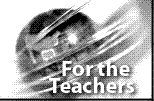|
We have all heard
young children repeatedly ask their mothers "why"
questions. "Why is spaghetti sauce red?" "Why
do bunnies have fur?" or "Why is Grandma's skin wrinkled?"
It seems natural and healthy for children to ask questions.
So what happens to that inquisitiveness between the ages of
two and twelve? By the time children are in middle school it
seems as if learning is torture. Teachers continually ask themselves
and their colleagues, "How can I make learning more interesting
for my students?" One option for teachers is problem-based
learning.
What Is Problem-Based
Learning?
Problem-Based Learning (PBL) is an instructional strategy
that bases learning around a real-world problem rather than
on a particular discipline. The strategy came about in the early
1970s in medical schools and has proven to be so effective
that is has made its way into K-12 instruction.
The idea is to teach
students to learn how to learn. By having to solve problems,
students practice learning rather than merely memorizing. Amazingly
enough, the students are not only introduced to facts while
solving the problem, but they remember them because the facts are no longer
a collection of random information--rather they are meaningful and
relevant to solving actual problems. Students learn to apply
new information to solve problems.
How Does PBL Work?
To begin, the students are given an ill-structured problem.
An ill structured problem is
a clearly defined problem that has just enough information to
provoke an investigation. The students should not have enough prior knowledge
to solve the problem on their own. This problem should have
more than one "correct" answer as the answer will most likely
change as more information is found.
Furthermore, it is
important that the problem be meaningful to the students. They
should be able to relate to the issue at hand. When students
??? to the issue, they will be more compelled to solve the problem and more
likely to retain the information they find.
Students should
then discuss
the problem and record all their prior knowledge. Based on what the students already know, each
group or individual can make a hypothesis or working statement,
which is likely to change as more information is deducted through
research. Next, students will brain storm a list of questions
that need to be answered in order to solve the problem.
Students will use
resources (e.g., Internet, encyclopedias, periodicals, experts,
etc. . .) to answer these questions. It is most desirable for
the teacher to have already decided on what resources the students
will use. This way the teacher can notify the school library
and/or gather resources in the classroom that will aid in the
students' discovery. This approach also saves students from searching
through useless materials.
This simple chart
can help students keep their objectives in order.
|
What
do I know?
|
What
do I need to know?
|
How
will I find it?
|
What Is the Teacher's
Role in PBL?
In a Problem-Based Learning scenario the teacher's
traditional role changes, and some teachers may need some time
to adjust. No
longer is the teacher and text the source of all knowledge in
the classroom. The role of the teacher in a PBL classroom is
as a coach or guide.
The teacher should
not expect students to be effective problem solvers right away.
Since learning to solve problems is one of the main goals of
PBL, students will need to be guided during the searching and
solving process. By asking questions along with the students,
a teacher can serve as a model problem solver. As students get
better at problem solving, the teacher's involvement may change
slightly.
However, there is
a fine line between guiding and modeling and being overly involved.
If the teacher guides all the students in the same direction,
the students will assume there is only one correct answer and
will most likely try to figure out what answer the teacher wants.
Also, the students will not take ownership of the problem if the
teacher does the work for them. Therefore,
it is important that the teacher allows students to question
things differently.
For More information
on Problem-Based Learning, check out these sites.
Problem
Based Learning: An Introduction
There
must be something compellingly effective about problem-based
learning, given the level of faculty interest in it all through
higher education. After all, no one thinks it's easier or takes
less time.
UD
PBL: Problem-Based Learning
University
of Delaware - Problem-Based Learning, Recipient of 1999 Hesburgh
Certificate of Excellence
Center
for Problem-Based Learning Core
The
CPBL web site is organized into four main sections: "What
is the CPBL?," "What is PBL?," "Who is working
with PBL?," and "What are we learning about PBL?."
|

